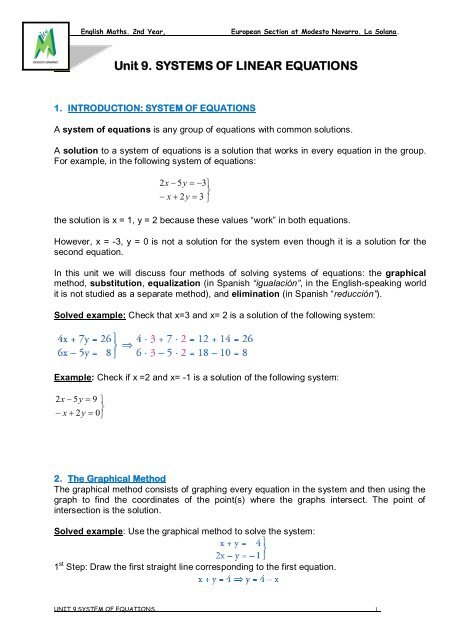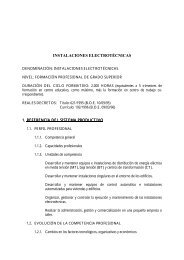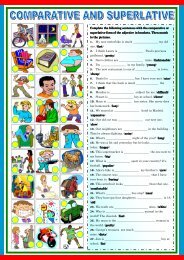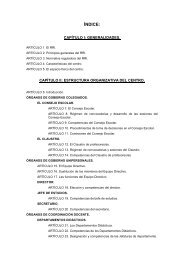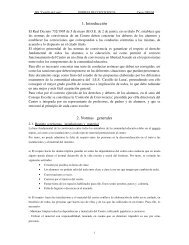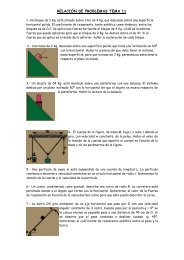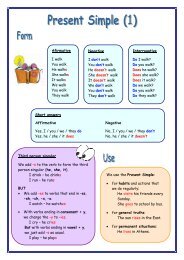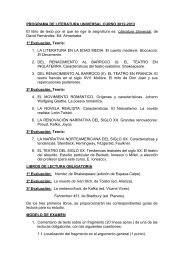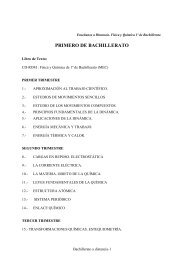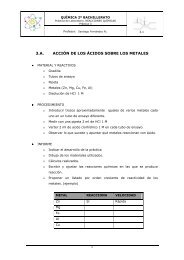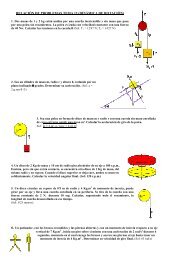Classnotes
Classnotes
Classnotes
You also want an ePaper? Increase the reach of your titles
YUMPU automatically turns print PDFs into web optimized ePapers that Google loves.
English Maths. 2nd Year, European Section at Modesto Navarro. La Solana.<br />
Unit 9. SYSTEMS OF LINEAR EQUATIONS<br />
1. INTRODUCTION: SYSTEM OF EQUATIONS<br />
A system of equations is any group of equations with common solutions.<br />
A solution to a system of equations is a solution that works in every equation in the group.<br />
For example, in the following system of equations:<br />
2x<br />
x<br />
5y<br />
2y<br />
3<br />
3<br />
the solution is x = 1, y = 2 because these values “work” in both equations.<br />
However, x = -3, y = 0 is not a solution for the system even though it is a solution for the<br />
second equation.<br />
In this unit we will discuss four methods of solving systems of equations: the graphical<br />
method, substitution, equalization (in Spanish “igualación”, in the English-speaking world<br />
it is not studied as a separate method), and elimination (in Spanish “reducción”).<br />
Solved example: Check that x=3 and x= 2 is a solution of the following system:<br />
Example: Check if x =2 and x= -1 is a solution of the following system:<br />
2x<br />
x<br />
5y<br />
2y<br />
9<br />
0<br />
2. The Graphical Method<br />
The graphical method consists of graphing every equation in the system and then using the<br />
graph to find the coordinates of the point(s) where the graphs intersect. The point of<br />
intersection is the solution.<br />
Solved example: Use the graphical method to solve the system:<br />
1 st Step: Draw the first straight line corresponding to the first equation.<br />
UNIT 9.SYSTEM OF EQUATIONS.. 1
English Maths. 2nd Year, European Section at Modesto Navarro. La Solana.<br />
2 nd Step: Draw the second straight line corresponding second equation.<br />
3th Step: The solution is the point of intersection of these straight lines: x = 1, y = 3.<br />
Example: Use the graphical method to solve the following system of equations..<br />
x y 2<br />
2x<br />
y 3<br />
Note: Carefully graph both equations very precisely. If you don’t graph neatly, your point of<br />
intersection will be way off.<br />
: Draw “x” and “y” axes.<br />
Graph the first equation, it’s a straight line: x-y = -2<br />
UNIT 9.SYSTEM OF EQUATIONS.. 2
English Maths. 2nd Year, European Section at Modesto Navarro. La Solana.<br />
Graph the second equation, it’s another straight line: -2x + y = 3<br />
The solution is the point of intersection.<br />
Example: Use the graphic method to solve the following system of linear equations:<br />
2x<br />
y 4<br />
NUMBER OF SOLUTIONS IN A SYSTEM OF EQUATIONS:<br />
A system of equations can be classified according to the number of solutions:<br />
UNIT 9.SYSTEM OF EQUATIONS.. 3<br />
x<br />
y<br />
Compatible system: if the system has got one solution, then the straight<br />
lines cut across each other in one point. Example:<br />
1
English Maths. 2nd Year, European Section at Modesto Navarro. La Solana.<br />
Incompatible system: if the system hasn’t got a solution, then the straight<br />
lines are parallel. Example:<br />
Example: Look at these graphics and write the solutions of these systems of equations:<br />
a) b)<br />
SOLUTION:_______________ SOLUTION: __________________<br />
TO REVISE THIS THEORY, YOU CAN VISIT THIS USEFUL AND ENJOYABLE WEBSITE, WHERE YOU<br />
CAN WATCH SOME VIDEOS. COME ON, GIVE IT A TRY!<br />
http://www.math-videos-online.com/systems-of-equations.html<br />
Exercise 1. Solve the following systems using the graphic method. Decide if they are<br />
compatible or incompatible:<br />
UNIT 9.SYSTEM OF EQUATIONS.. 4
English Maths. 2nd Year, European Section at Modesto Navarro. La Solana.<br />
Exercise 2. The addition of two numbers is equal to 5. Write an equation expressing this<br />
condition and calculate five pairs of solutions. Draw this set of solutions.<br />
Exercise 3. The subtraction of two numbers is 1. Write an equation expressing this<br />
condition and calculate five pairs of solutions. Draw the set of equations.<br />
UNIT 9.SYSTEM OF EQUATIONS.. 5
English Maths. 2nd Year, European Section at Modesto Navarro. La Solana.<br />
Exercise 4. Solve the following system of equations using the graphic method:<br />
3. Substitution Method<br />
The method of solving "by substitution" works by solving one of the equations (you choose<br />
which one) for one of the variables (you choose which one), and then using this (or plugging<br />
this back) in the other equation, "substituting" it for the chosen variable and solving the<br />
other. When you know the value of the second variable, you can easily calculate the first<br />
variable (back-solve for it).<br />
Here is how it works. (We'll use the same systems that we used in the previous pages.)<br />
Solved example: (substitution method)<br />
The idea here is to solve one of the equations for one of the variables, and<br />
replace that variable with this in the other equation (plug it in the other equation). It<br />
does not matter which equation or which variable you choose. There is no right or<br />
wrong choice; the answer will be the same either way. However, some choices may<br />
make the calculations easier than others.<br />
For instance, in this case, we can see that the simplest way is probably to solve the<br />
second equation for "y =", since there is already an isolated y in the middle of the equation:<br />
y 24 4x<br />
UNIT 9.SYSTEM OF EQUATIONS.. 6<br />
2x<br />
4x<br />
3y<br />
We could also solve x , but we would get fractions:<br />
x<br />
24 y<br />
4<br />
Solving the first equation for either variable would also give me fractions. It wouldn't<br />
be "wrong" to make a different choice, but it would probably be more difficult. So it is easier<br />
to solve the second equation for y:<br />
1 st step: Work out the value of “y” in the second equation (because it’s the easiest one)<br />
2x<br />
3y<br />
2<br />
y<br />
24<br />
4x<br />
2 nd step: Now plug this into the first equation (substitute it for y in the first equation), and<br />
solve it for x:<br />
y<br />
24<br />
2
English Maths. 2nd Year, European Section at Modesto Navarro. La Solana.<br />
2x – 3(–4x + 24) = –2<br />
2x + 12x – 72 = –2<br />
14x = 70<br />
x = 5<br />
3 rd step: Calculate the value of the other unknown. We can plug this x-value into either<br />
equation, and solve for y, but since we already have an expression for "y =", the simplest<br />
solution is to just plug it in there:<br />
y = 24 – 4x<br />
y = 24 – 4(5) = 24 – 20 = 4<br />
Then the solution is (x, y) = (5, 4).<br />
Warning: If you substitute the "24 – 4x" expression into the same equation that you have<br />
used to solve for "y =", you get a true, but useless, statement:<br />
4x + (–4x + 24) = 24<br />
4x – 4x + 24 = 24<br />
24 = 24<br />
It is true that twenty-four equals twenty-four, but that doesn’t help us. So when using<br />
substitution, make sure you substitute into the other equation, or you'll just be wasting your<br />
time.<br />
Solved examples. Visit these webpages to watch some videos which revise the<br />
substitution method:<br />
http://video.google.com/videoplay?docid=-6836161716522364284#<br />
http://www.ehow.com/video_4754360_solve-equations-substitution.html<br />
Exercise 5. Solve the following system using the substitution method. Write if it is<br />
compatible or incompatible:<br />
a)<br />
b)<br />
UNIT 9.SYSTEM OF EQUATIONS.. 7
c)<br />
d)<br />
English Maths. 2nd Year, European Section at Modesto Navarro. La Solana.<br />
UNIT 9.SYSTEM OF EQUATIONS.. 8
English Maths. 2nd Year, European Section at Modesto Navarro. La Solana.<br />
4. “Equalization” Method.<br />
This method consists in:<br />
1 st step: Work out the value of the same variable in both equations. (You choose the<br />
variable)<br />
2 nd step: Make both expressions equal.<br />
3th step: Solve this equation.<br />
4 th step: To calculate the value of the other variable, plug the first back into one of the<br />
equations, "substituting".<br />
Example: Solve using the Equalization Method:<br />
Solution:<br />
Exercise 6. Solve using the Equalization Method.<br />
a)<br />
b)<br />
UNIT 9.SYSTEM OF EQUATIONS.. 9
English Maths. 2nd Year, European Section at Modesto Navarro. La Solana.<br />
5. Elimination or addition method.<br />
To learn the procedure to solve a system of equations using the elimination<br />
method, please visit these videos in the following websites:<br />
http://www.youtube.com/watch?v=xB-oXaCoJoc<br />
http://www.youtube.com/watch?v=ej25myhYcSg<br />
Solved example: Solve the system of linear equations.<br />
multiply all the terms in the second equation by 3<br />
-2x + 3y = 8<br />
9x - 3y = -15<br />
add the two equations (you can also subtract them if it is easier)<br />
7x = -7<br />
Note: y has been eliminated, hence the name: method of elimination. Now solve the<br />
above equation for x:<br />
x = -1<br />
replace x with -1 in the first equation:<br />
-2(-1) + 3y = 8<br />
solve the above equation for y:<br />
2 + 3y = 8<br />
3y = 6<br />
y = 2<br />
write the solution to the system as an ordered pair:<br />
(-1,2)<br />
check the solution obtained:<br />
first equation: Left Side: -2(-1) + 3(2)= 2 + 6 = 8<br />
Right Side: 8<br />
second equation: Left Side: 3(-1)-(2)=-3-2=-5<br />
Right Side: -5<br />
UNIT 9.SYSTEM OF EQUATIONS.. 10<br />
3x<br />
2x<br />
y<br />
3y<br />
5<br />
8
English Maths. 2nd Year, European Section at Modesto Navarro. La Solana.<br />
conclusion: The given system of equations is consistent, and it has the ordered pair<br />
which is shown below as a solution.<br />
(-1,2)<br />
Exercise 6. Solve the following systems using the most suitable method and classify<br />
them:<br />
a)<br />
b)<br />
c)<br />
d)<br />
e)<br />
UNIT 9.SYSTEM OF EQUATIONS.. 11
f)<br />
English Maths. 2nd Year, European Section at Modesto Navarro. La Solana.<br />
NOTE: if you want to practise more, you can visit this website on the Internet:<br />
http://www.emathematics.net/sistecuaciones.php?ejercicio=simple&def=find<br />
UNIT 9.SYSTEM OF EQUATIONS.. 12
English Maths. 2nd Year, European Section at Modesto Navarro. La Solana.<br />
6.PROBLEMS WITH SYSTEMS OF EQUATIONS.<br />
Exercises: Page 178, exercises: 65, 66, 67, 68, 69, 70, 71, 72, 73, 74, 75, 76.<br />
Exercise 7. The admission fee at a museum fair is $1.50 for children and $4.00 for adults.<br />
On a certain day, 2,200 people visit the museum, and they pay a total of $5,050. How many<br />
children and how many adults visited the museum?<br />
Exercise 8. The air-mail rate for letters to Europe is 45 cents per half-ounce, and to Africa it<br />
is 65 cents per half-ounce. If Shirley paid $18.55 to send 35 half-ounce letters abroad, how<br />
many did she send to Africa?<br />
UNIT 9.SYSTEM OF EQUATIONS.. 13


